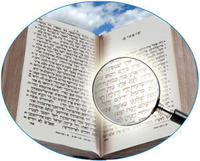Kabbalah Explains the Bible
What does it take to author the greatest bestseller of all time? Apparently, it takes as much as discovering a world where there are no words at all, and finding words from our world to describe it
But that’s not all. As a baby, the author of the Bible was found by the daughter of the ancient Egyptian ruler, Pharaoh, lying in a papyrus crib by the banks of the Nile River. He was raised in Pharaoh’s house and lived like a king’s son, having everything one could desire. But one day, Moses found he could no longer remain in that setting and embarked on a journey that led him to discover the Upper World.
And even though Moses found himself in different places, the Upper World he discovered was not at all a physical place somewhere on the globe. It was rather an inner world of completely new sensations, unattainable to our regular five senses.
When we think about a “world,” the picture that probably pops up in our mind is of some vast physical space filled with all kinds of objects, plants, animals and people. However, the Upper World is sensed through a person’s internality, where one connects to the driving forces behind the reality we perceive through our five senses, called “our world.” And at the highest level of the Upper World, one discovers that all these forces are connected into a single, all-inclusive Upper Force, called “Upper Light.”
Words of this World, Meaning of the Upper World
Even though Moses wrote his book thousands of years ago, the Bible is still the most famous book ever written. It was originally written in Hebrew, and its Hebrew name, “The Torah,” gives us an insight into its true meaning and intent: The word Torah comes from the Hebrew words Ohr—Light, and Hora’a—instruction. Thus, the book is an instruction manual on how to feel the Upper Light, found in the Upper World that Moses had discovered.
But since there are no words in the Upper World, The Torah uses words from this world to describe it. How can our normal words describe the Upper World? Kabbalah explains that the spiritual forces within the Upper World govern everything in our world, and hence, every force in the Upper World is manifested in our world. The forces in the Upper World are called “roots,” and their manifestations in our world are called “branches.” Thus, the language used in The Torah is called “The Language of Branches.”
It works like this: When Moses wanted to describe something in the Upper World, he named it after its branch in our world. For instance, if a spiritual object manifests in our world as a stone, he called that spiritual object “a stone.” So the word, “stone,” did not refer to the stone we see and feel in our world, but to the spiritual root that manifests in our world as a stone.
In the same way, every word of the Bible describes the happenings of the Upper World. And when read this way, the book is used the way the author had intended: as a guide for one who embarks on the journey of spiritual discovery.
When Words Lose Their Meaning
Thousands of years have passed since Moses produced this monumental book, and as time went by, the true Kabbalistic meaning of the Bible was forgotten. Instead of reading it in order to enter the Upper World and feel the Upper Light, many people began thinking that the book talked about our world: about relationships between people, moral teachings, and advice on arranging our mundane matters. Others believed that this book was a historical narrative. Either way, these are all misinterpretations of the text, since it is written in the Language of Branches and deals only with the Upper World.
And yet, there is archaeological evidence that the historical events described in the Bible actually happened in our world. Do Kabbalists maintain that none of these events actually took place in our world? No, just the opposite: They help us see why they all had to happen in our world.
As said above, every object and event in this world is brought about and governed by its root in the spiritual world. Therefore, if a spiritual object exists, it has to manifest in our world as well. That’s why, although the Bible describes only the Upper World, the corresponding events must have taken place in our world as well.
Reading Kabbalah Correctly
The key discernment here is that Kabbalists consider the spiritual objects and events— the roots—infinitely more important than their material consequences. They explain that a Kabbalist with the exceptional spiritual attainment of Moses could not have written a word with the objective of telling us about history or ethics. Rather, his only purpose would be to reveal the Upper World to mankind, to help us feel it the way he did and thus help us attain the highest goal of our existence.
Therefore, the right way to read The Torah is to see that its every word refers to a spiritual force found in the Upper World. Then one begins to gradually connect to these forces and feel them, just as Moses did.
Those who have already developed an ability to feel the Upper World are called “Kabbalists,” and when they read The Torah they don’t envision historical events or moral teachings. Instead, they clearly sense how spiritual forces govern us and everything around us, and how everything unites in the infinite, perfect Upper Light.
